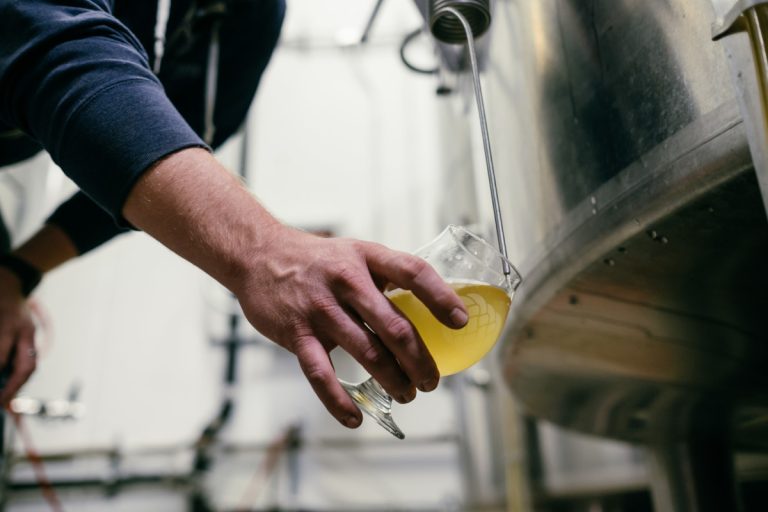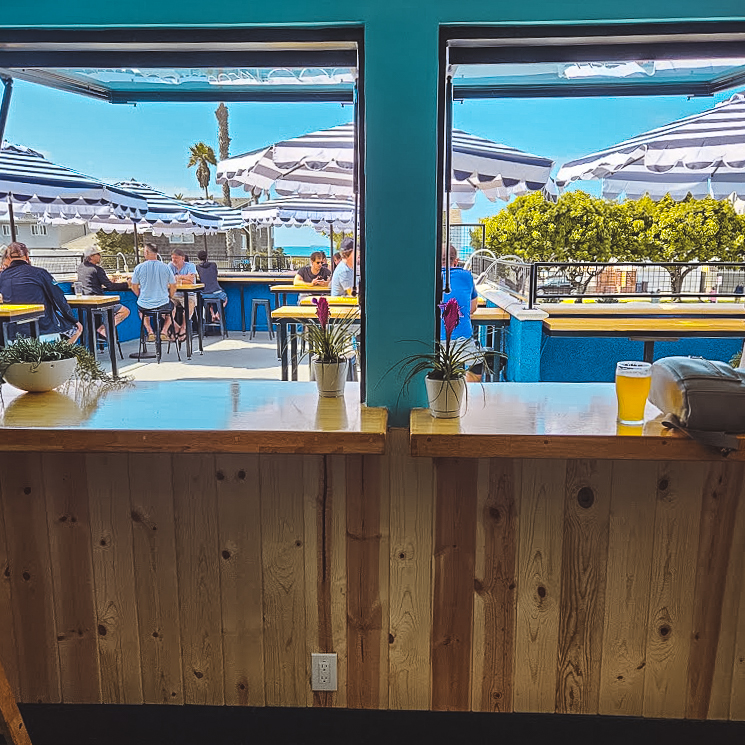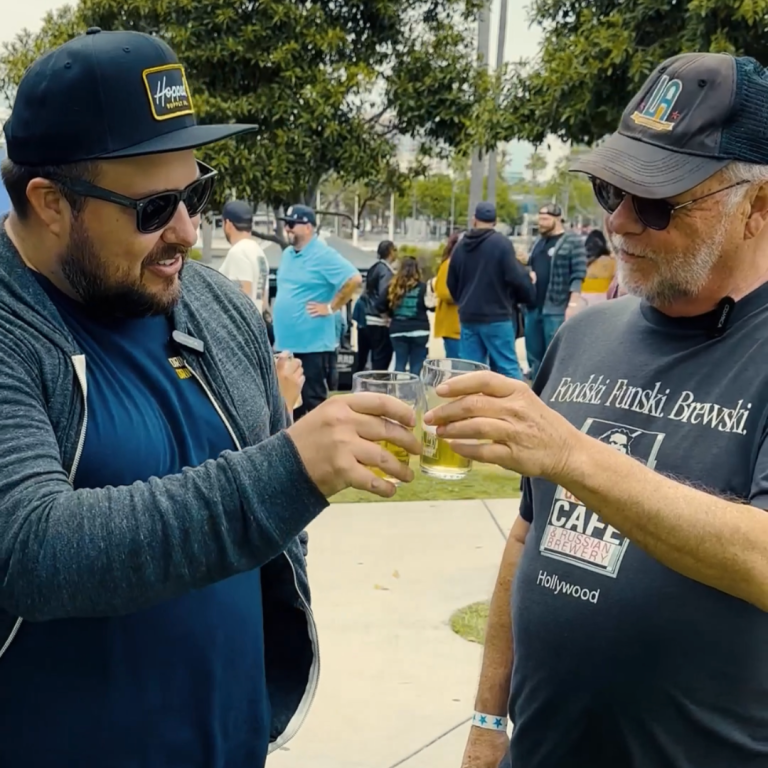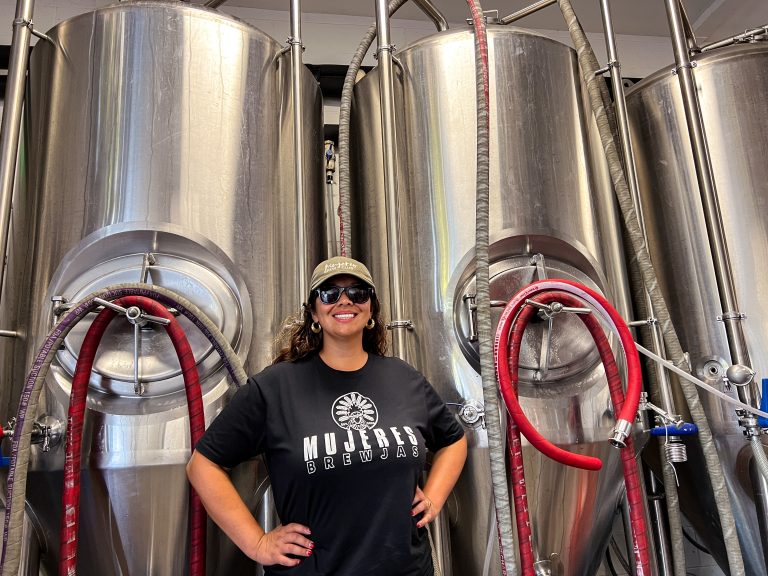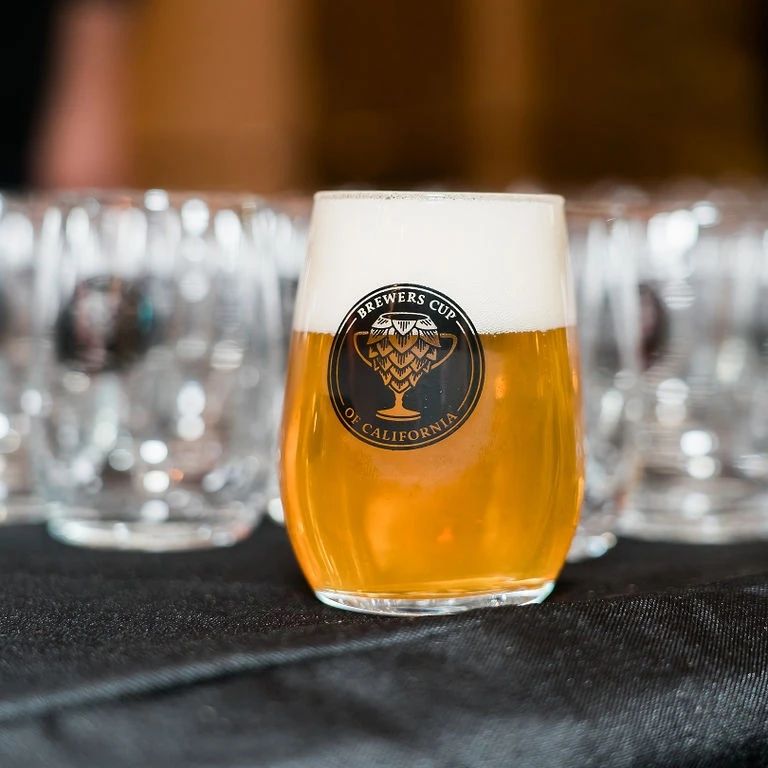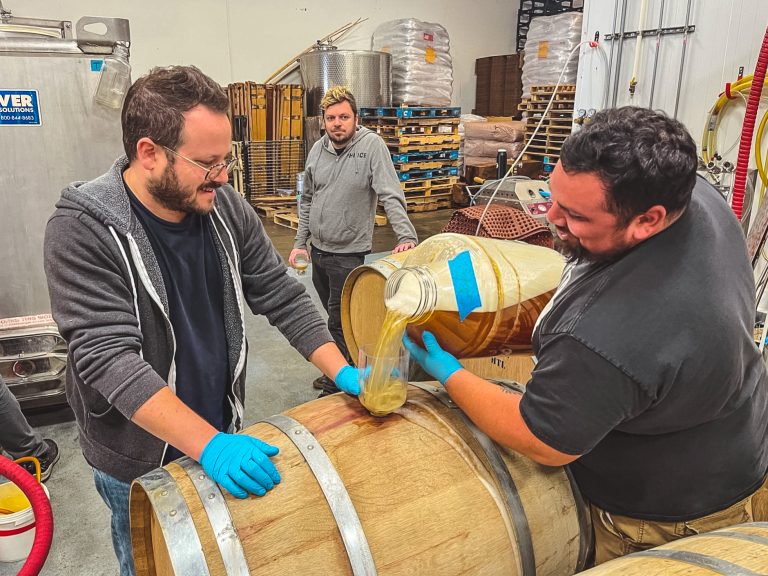We met Kara Avery inside the Lancaster staple Bravery Brewing, which celebrated its 10th anniversary earlier this year. At Bravery, Kara is the Co-Owner and General Manager, and Hopped sat down to talk to her about the intersection of wine and beer, what makes Bravery unique in the crowded LA landscape, and how her work as a flight attendant has impacted her taste for beer.
This interview has been lightly edited for clarity and length.
As told to Mark Smolyar and Cambria Findley-Grubb for Hopped.
HOPPED: How did your craft beer palate start to develop?
KARA: I have been interested in craft beer basically since I was legal to drink. I began working in the restaurant industry when I was 18 and worked at Yard House before it was acquired by Darden, so I initially learned a lot about beer there, as they were so focused on bringing in different styles of local beer.
Before that, I lived in Colorado and there was this little liquor store down the street from me. I would talk to the guy who worked there and ask him a ton of questions like “ What’s your favorite part of running this store?” And we ended up talking a lot about craft beer. About once a week I would go there and he would always tell me when he ordered a new style of beer, and the next time I came in I would talk to him and tell him what I liked. Early on I remember trying beers like Sea Dog Blueberry Wheat Ale and Rogue Hazelnut Brown. Through trying different beers, I really started liking Browns, starting with Newcastle, and then I got into Hefeweizens and Belgians, and then IPAs, and now I love everything.
The Beginning
HOPPED: How did you start working at Bravery?
KARA: I have known my husband Brian Avery, who co-founded Bravery Brewing, for almost two decades. We met in high school Spanish and have been friends ever since. When Brian decided to open a brewery, I was supportive of him from the beginning. I have been visiting Bravery since there was a chalkboard menu and, like, two beers on tap. It’s been amazing seeing all the growth and being involved in the craft beer community, but I wasn’t sure there was a place for me professionally in this field. Then the pandemic happened and in March of 2020, I shifted over to working at Bravery. No one was allowed to serve beer on-site, so I started helping out filling crowlers and growlers to sell out the door.
I took an 18-month leave from my job as a flight attendant and committed to being on the Bravery team for at least 18 months. It was intimidating coming into an already established business, but during the pandemic, I was able to help completely reshape it. Prior to working here, I had done everything in the service industry. I had done banquets, serving, bartending, cocktail service, etc and that gave me the perspective to see what was working and what wasn’t. I am really lucky to have partners that respect my background and where I am coming from. We have great communication. At the beginning of COVID, it was a skeleton crew of myself, Brian, his parents, and our former brewer. Even though we are outside of Los Angeles and have a huge open-air space, we are still LA County and had to abide by all the LA County regulations, so that made for a unique challenge joining the team at that time.

HOPPED: Can you tell us more about your work path prior to working at Bravery?
KARA: I have worked as a flight attendant since 2014 and also own my own business Wine Bees, which does wine education and events. I love my job as a flight attendant, but a few years ago I felt like I was at a crossroads and I wanted to pursue something else on the side as well. I was talking to my best friend and I mentioned that I wanted to pursue a career in business and she asked me, “So you’re going to sit at a desk from nine to five?,” knowing that wasn’t me. She brought up that I love being outdoors, I love wine, and I love learning, so why not look into a career in viticulture. I started taking classes at the University of Missouri’s viticulture program, and they had an internship program with wineries. Students go and stay at the winery and help with the whole process, not just the harvest, but also growing the grapes. For about nine months, I was working with a winery run by two retired school teachers outside of Sacramento. I would fly up to Sacramento, rent a car, drive to their house, and stay with them for two or three nights a week to help with the grapes. I got to be a part of so many interesting decisions, and Brian helped with the harvest.
One weekend a few years ago, I wanted to find a fun wine event for Brian and I to go to, and we looked if there were any near us. And no, we’d have to go all the way to Downtown LA. There was nothing fun going on within an Uber distance. So, I decided to create my own business doing wine education and events.
Grape vines don’t need bees to grow since they are self-pollinating, but bees like hanging out with them. It’s this happy, symbiotic relationship where they don’t need each other, but they love each other. The business is named Wine Bees. My goal is to educate people how to shop for wine [and] pair wine, what to look for on the label, and to make it simple. Affordable wine can be excellent and delicious, and you can have a wonderful experience with the smallest tidbits of information.
Always Be A Student
HOPPED: As a flight attendant, how have you been able to coalesce your love of travel and beer?
KARA: My motto in life is to always be a student. I think it’s important to remain humble and to continue to educate yourself, regardless of your status, age, where you are in your life, and seeing the world helps me with that. Everywhere I go I try to learn something new and I also try to drink something new.
As a flight attendant, I travel alone for the most part since not everyone you work with has the same interests. I am a very assertive person, so I always have a plan. For example, when I get to Brussels, I am going to Delirium. Before COVID, I had a goal to visit a winery and brewery in every state, and that’s something I want to start up again
BRIAN: Can I chime in? We went to Spain three years ago and we got to spend so much time engrossed in the experience. If you go to your favorite wine retailer here, maybe they have a small selection of Spanish wines, and if you want to go crazy you can buy all bottles and take them home. I am sure that is an experience you can glean something from. But spending several days in a region and drinking the local wine, you’re not only drinking a lot of it, but it’s the contextual icing with the culture, and people, and the winemakers, and getting those experiences.
KARA: A few years ago, I stumbled upon an article about Mendocino as a wine region and told Brian “Take a few days off, we are going.” We flew into the Sonoma airport and explored that region, a few months later we ended up eloping there. I am an avid reader, any time I read about a destination and have an option I say “Yeah, let’s go!” If I am reading about a style of beer, wine or food and it sounds weird, interesting, or awesome, I am going to try it.
Wine And Beer
HOPPED: How have you been able to combine your interest and background in wine into Bravery Brewing?
KARA: One of the things I do at Bravery is wine education. I earned my Level 1 Sommelier, as well as my WSET level 1, and have taken other specialized wine courses. If I am going to be educating people about wine then I need to know what I’m talking about.
Since we have a kitchen on-site, we are able to sell wine as well, so I curate our wine list. We carry bottles from all six local wineries around here and also have four wines on tap. We have a model where you can try every wine on tap and not feel bad about opening a bottle. Our goal is for customers to taste everything and not be intimidated, as trying wine for the first time can feel intimidating. While we have a beer flight, we also have a wine flight.
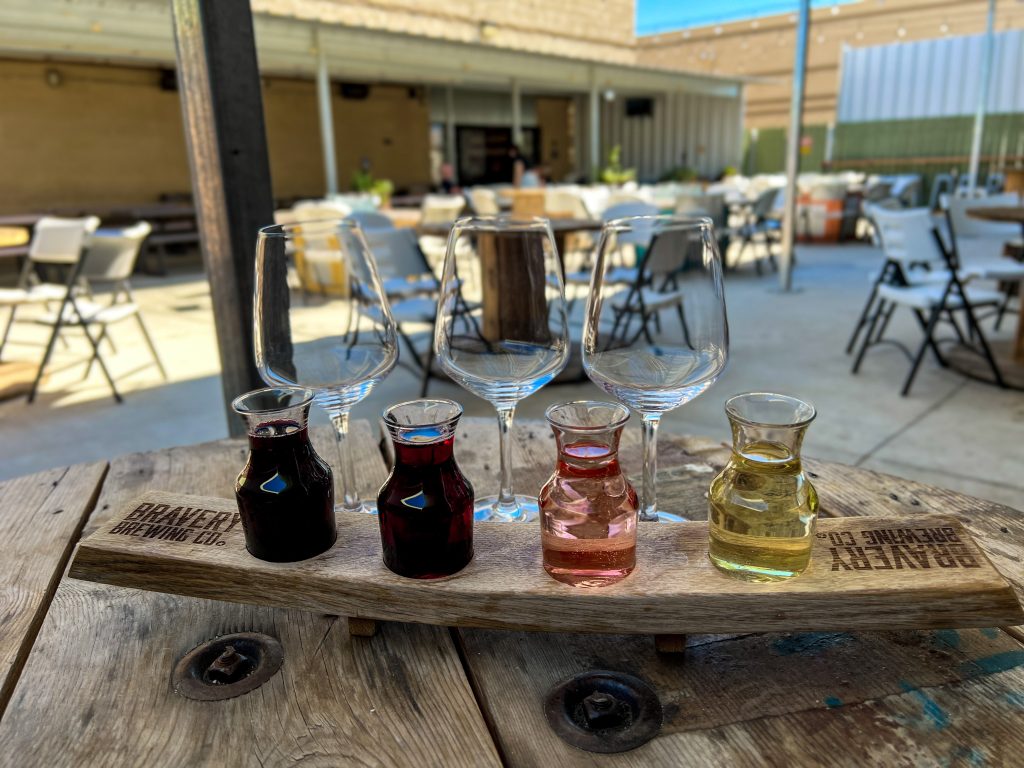
My goal is always to elevate and educate. Although we offer Chardonnay in bottles, we didn’t put it on tap for a reason, and that’s due to people discovering they like a widely available style such as Chardonnay and then they get the same thing every time they go out. Instead, our white wine on tap is a Sauvignon Blanc. I believe Sauvignon Blanc is the white wine of beer drinkers. It’s bright, and it pairs well with our pizza and charcuterie box.
BRIAN: Phantasm Powder, which is added to some beers, comes from the skins of Sauvignon Blanc Grapes. That is what is creating the fruitiness and tropical fruit notes that are in a Sauvignon Blanc wine. Like when you drink a hefeweizen and you’re tasting a banana, it’s because it’s the same chemical compound that makes a banana taste like a banana. So with Phantasm you’re unlocking the same type of flavor notes that this wine has.
KARA: We also have a sparkling wine program featuring three different countries.We have quite a few baby showers and wedding receptions, and people want to drink bubbly when they are celebrating.
One of my favorite things to say is that beer belongs at the table. I think beer goes with food, as well as wine, and sometimes even better. We have hosted wine versus beer events here at the brewery to see which pairs better with different foods.
The Food
HOPPED: Can you tell us more about your kitchen?
KARA: COVID really played our hand there. Brian and I are really into cooking, and with Wine Bees we always offered smaller food pairings and once actually put on a five-course dinner for 60 people. We are a small town and there are only so many food trucks. We enjoy all our local food trucks, but it’s a vehicle which can break down, and with COVID we were required to have food on-site to sell beer. We then decided to build a kitchen, as we saw COVID wasn’t going anywhere.
All of the initial recipes are Brian’s, and we had secret gatherings where people could test the [pizza] dough, they could tell us what sauce was better. Our salads are the same salad I make for myself at home. And of course, we have a charcuterie box, which has soft, medium, and hard cheeses, seasonal fruits and nuts, and cured meats. I wanted to have it all go together and pair well with a few beers and wines, as well as using small, locally focused cheesemakers.
One of my favorite parts of our kitchen though is our Pizza with a Purpose program. We have always been involved with nonprofits and charities in some capacity, however, there are a lot of rules when it comes to alcohol and nonprofits. Through opening up a kitchen, it has allowed us to work more seamlessly with nonprofits. One dollar from every pizza we sell goes to a nonprofit that we picked for that month. We ask our employees and returning customers if there is a nonprofit they are excited about supporting and want to learn more about. Who we sponsor rotates every month. In October, it was the Basset hound rescue we got [our dogs] Watson and Winnie from. In November, we had WAVES, which is Wounded American Veterans Experiencing Scuba. I know we are in the desert but we have a really strong scuba diving club out here, and WAVES teaches veterans how to scuba dive for free. For a few years now we have made “Under the Waves IPA” for them. This is extra exciting for us because we are both licensed scuba divers.
Bravery’s Barrel Program
HOPPED: So you enjoy learning about the education side of beer as well as wine?
KARA: Through my viticulture program I learned I don’t want to be in agriculture. Spoiler alert, I didn’t start my own winery. I still love seeing every part of the process of making beer and wine. Brian and I even made an ‘I Do’ Brut IPA for our wedding together.
One of my favorite parts of the brewery is the barrel program. I am always popping in over there, asking “What’s going on? When are we putting the beer in barrels?” I enjoy watching the process. We have a bourbon barrel-aged Russian imperial stout with cacao and hazelnuts, and my favorite fact to tell customers is that our team was skinning hazelnuts next door for two days.
During the pandemic, I really developed such a love and understanding for the barrel-aging program because I really had the time to sit down and experience them and the process. Similar to wine, there is so much synergy around the pairing with food and the experience you get from the barrels. We have a Scotch barrel-aged Russian imperial stout that I love with Gruyere cheese. I’m always telling people to go to Trader Joe’s, buy every kind of cheese, and experience them with these beers. We have 34 taps, meaning we tend to have quite a few barrel-aged beers on tap at all times. Being able to sit down with a small amount, try the beer and cheese, pair it, and experience it in different ways. It’s just so beautiful. You can taste how many different layers there are to barrel-aged beers, and just see how the different barrels have added nuance to the beer. Scotch, rye, bourbon, tequila, rum, we put the beer in all different kinds of barrels and you can really experience the flavors without adjuncts.
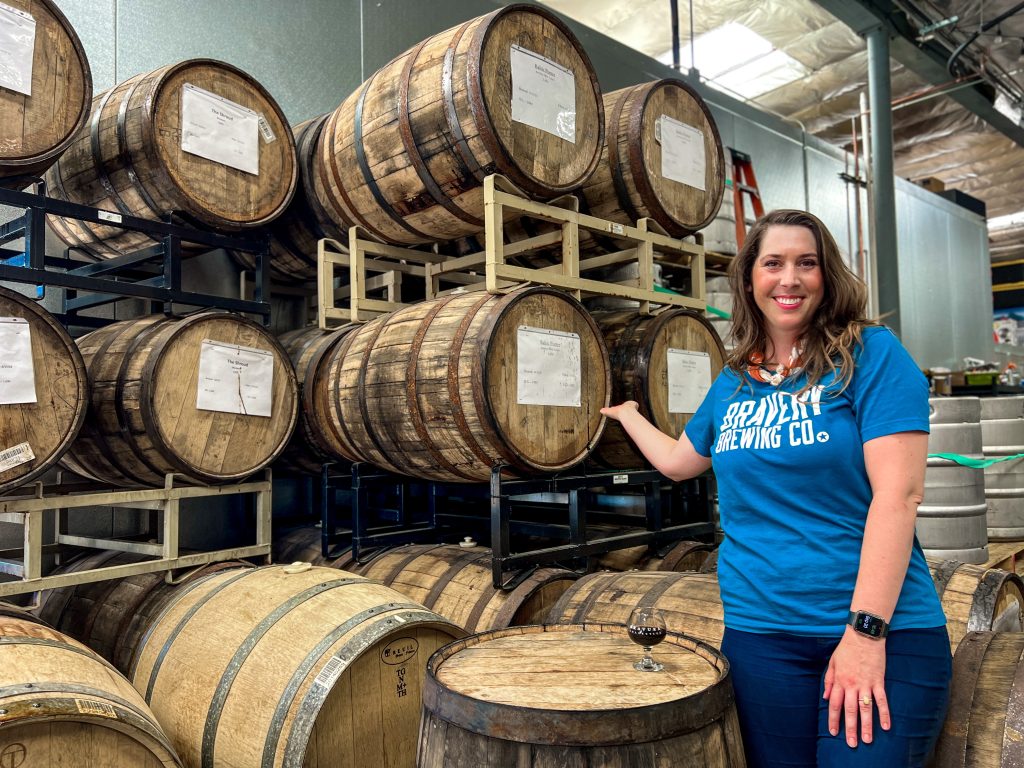
BRIAN: In this area, we have really intense seasonal weather. It gets up to 115 for sustained periods of time in the summer, and we get snowfall most winters. Being in the high desert we have temperature swings just on the same day. With those seasonal and daily temperature swings, the beer is always expanding and contracting in the barrel. We do a full 12-month cycle for all of our barrels. I think compared to a lot of other barrel programs that are in perhaps a coastal area or more temperate climate, for us it’s as if we’re wringing everything out of the staves. Our beers are very barrel forward. My personal palate really comes out through these beers because I don’t have a sweet tooth and I really enjoy most spirits. So you know whether it’s having a beer aged in Scotch or mezcal barrels, our beers will be balanced but not really tipping towards the sweeter side.
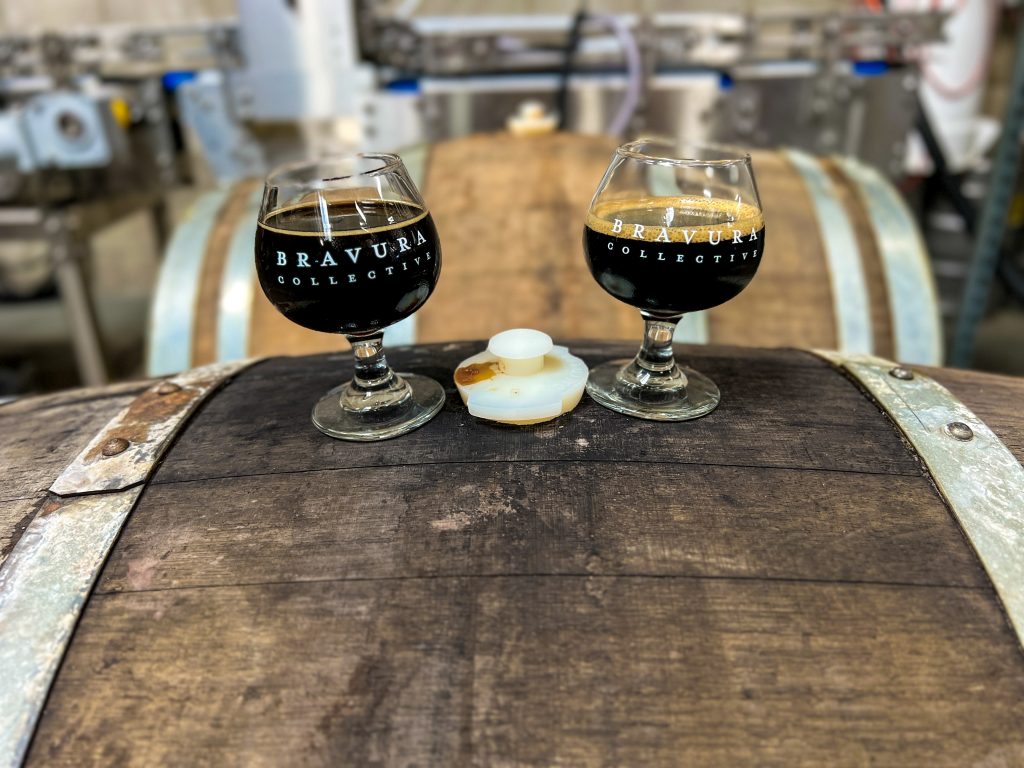
KARA: It’s also interesting to see that seasonality impacts our taproom and what people want to drink. In the summer we will be going fast through our kölsch and our German-style hefeweizen, and then winter rolls around and it’s all about our Russian imperial stout. All of the barrel-aged beers move so much quicker in the wintertime than in the summer.
The Pandemic’s Impact
HOPPED: Have you seen any changing demographics in your taproom since the pandemic?
KARA: When we brought in food, people were all of a sudden like, “Oh my gosh, kids are allowed now!” Kids have always been allowed. We have always been a family and dog friendly establishment, but people are still surprised by it. About 50% of the time we have cask ale available and we get to introduce people to their first pint of cask ale ever, which is super cool. With more people coming in, there is more education to be done about who we are and different styles of beer. We are also constantly doing education for our employees and are working on doing education in the most fun way possible. We offer beer and wine education classes for our employees, and if it doesn’t fill up with the beertenders, we encourage our brew team and 21+ pizza team to join as well.
We also do beer and wine pairing events for the community. For instance, there is a local chocolatier and we have had him come out and pair beer with his chocolates.
My goal for 2022 was not to yuck anyone’s yum, and I truly enjoy seeing people experience and enjoy something, even if it isn’t my favorite. Everything is an education. I’m always here to learn and soak up what other people have to offer. We love visiting other breweries too. I enjoy going out to eat at places out of my comfort zone and trying new things. I feel like those experiences have helped me talk to customers about what they want. For instance, a customer comes in saying they enjoy Coors Banquet, I’ll suggest our Cream Ale and they typically enjoy the beer as well as the fact they’re trying something new. That kind of connection with our customers is very important to me.
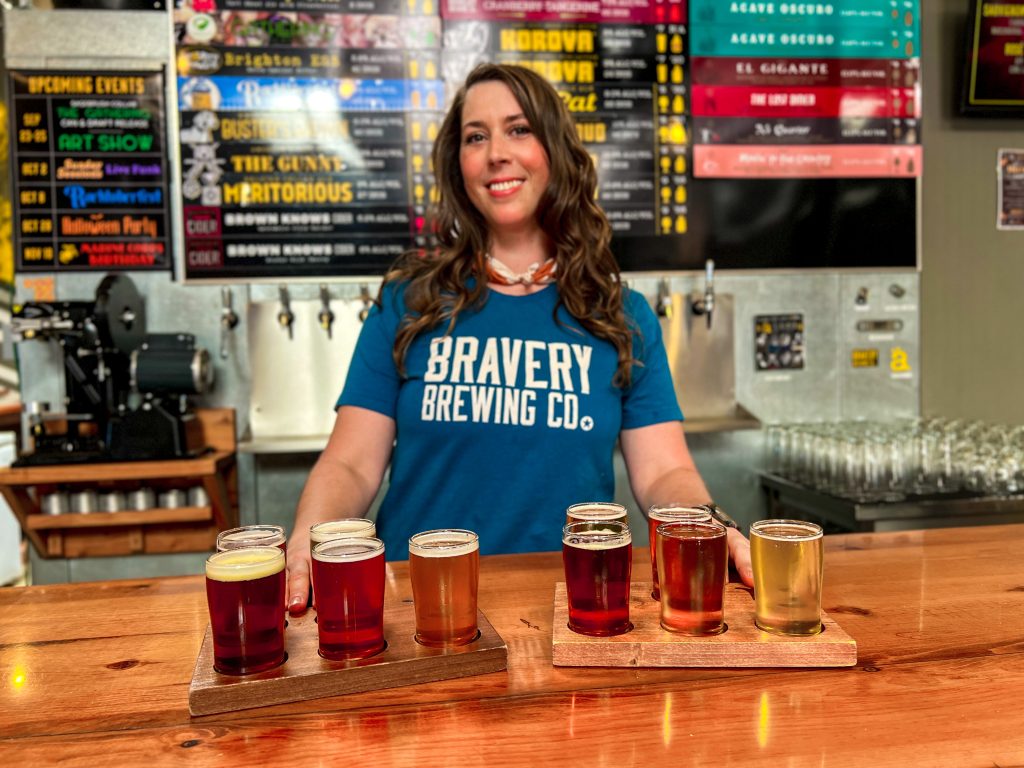
Call Sign: Bravery
HOPPED: Where did the name Bravery Brewing come from and how does it relate to the military connection to the brewery?
KARA: I will leave that one for Brian.
BRIAN: I went to school for film studies, and with a crew of 80 people there are going to be, like, five Brians. One day one of the grips came over and tore the tape off my walkie and put it back together and told me my walkie handle was Bravery now (Brian Avery) because “I am sick and tired of all these Brian’s stepping on each other’s walkies.” And so for about a year-and-a-half, Bravery was my radio call sign.
But there is a double meaning as well. R. Lee Ermey was one of our co-founders and he is the other half of why we are called Bravery Brewing. R. Lee Ermey was in Full Metal Jacket, The Gunny beer is named after him and you can see his regalia inside as well. He was a close family friend, golf buddies with my father, and a really solid member of the community out here. At the time when we decided to open a brewery, I was 24 and sitting down with R. Lee Ermey, who is such a nice guy but also still a drill sergeant. So we were spitballing over what to call the brewery. We were going to call it Lancaster Brewing Company, but that was kinda boring. So, the name Bravery came up, and everyone unanimously liked the idea and the double meaning behind it. Also, this is a community founded by aerospace and just to the north of us is Edwards Air Force Base, so this community is filled with service members. So we give every veteran $1 off every beer whenever they come in. When we opened bravery, the first thing we did was paint the giant American flag on the wall which we call the Wall of Bravery.
My great-grandfather served in World War II and was killed in action. He was a commander of a destroyer and his photo was the first wall that went up on the wall of Bravery. So, if you look at it, it is a mixture of living and deceased service members. It is word of mouth and totally open to the community and over the last ten years the wall has really filled up with people bringing in photos of themselves or their loved ones. It’s just a really cool tribute to our service members that has been driven by our community. Most good tap rooms are built over time by their community. You guide it in the direction that you want it to go, but then the community kind of dictates what your tasting room is going to become, which is really special.
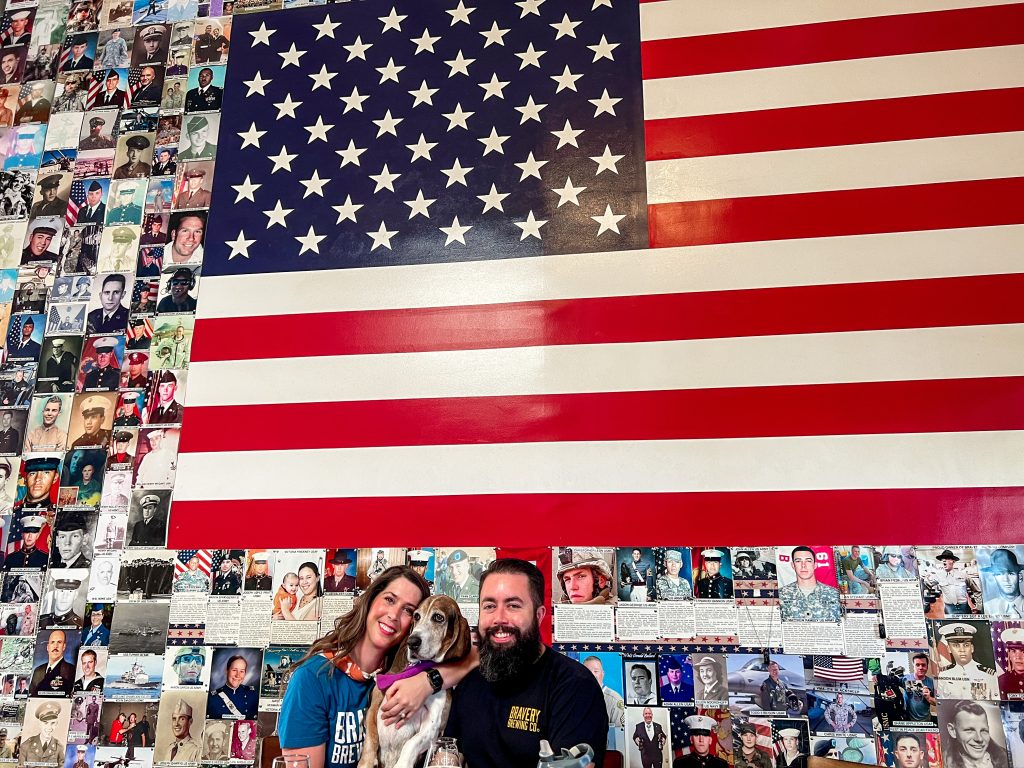
The Community
KARA: We’re always trying to put on events that are locally focused and bring different people in here from the community. We have hosted an art show where we work with all local artists and worked with our local coffee shop. We host our huge harvest festival. It’s great to connect with the local community however we can.
HOPPED: Can you talk a bit about the collaborative competition between breweries?
KARA: People tend to ask me how I feel about other breweries and I ask them in return, “Do you want to go out of town and not have a place, or have only one spot to get a beer?” And of course, they don’t. “Same.” You don’t want to have steak for dinner every night. Beer is a beautiful community. I look forward to visiting breweries, whether it’s within LA County, the state of California, or if I am in Portugal, I want to be able to experience things outside our brewery. Number one, it’s fun. Number two, it’s Delicious. And number three, it’s a learning experience. I don’t think of it as competition within our industry, we are all different. I’m really close with all the winemakers out here, and we talk about how we all start out with the same grapes, and even with beer everyone has their own spin on the same ingredients. That’s the beautiful thing about beer – I personally want to try different things all the time.I find it more to be about collaboration and trying new things than any sort of competition.
HOPPED: What advice do you have for women who may be interested in getting involved in the beer industry?
KARA: Besides the brew team, every leader we have here at Bravery and in management is female. Our Kitchen Leads, Tasting Room Manager, and Head of Distribution are all female. We are a very woman-focused and female-friendly business. If you have interest in craft beer, the first step is to go to a brewery and sit at the bar and talk to the bartender. That’s what I started doing when I was initially learning about beer. The bartenders are usually there because they care about beer too, and they are happy to talk to you and have a conversation. Once you’ve had a conversation, you start developing these relationships, which makes it easier to enter the industry.
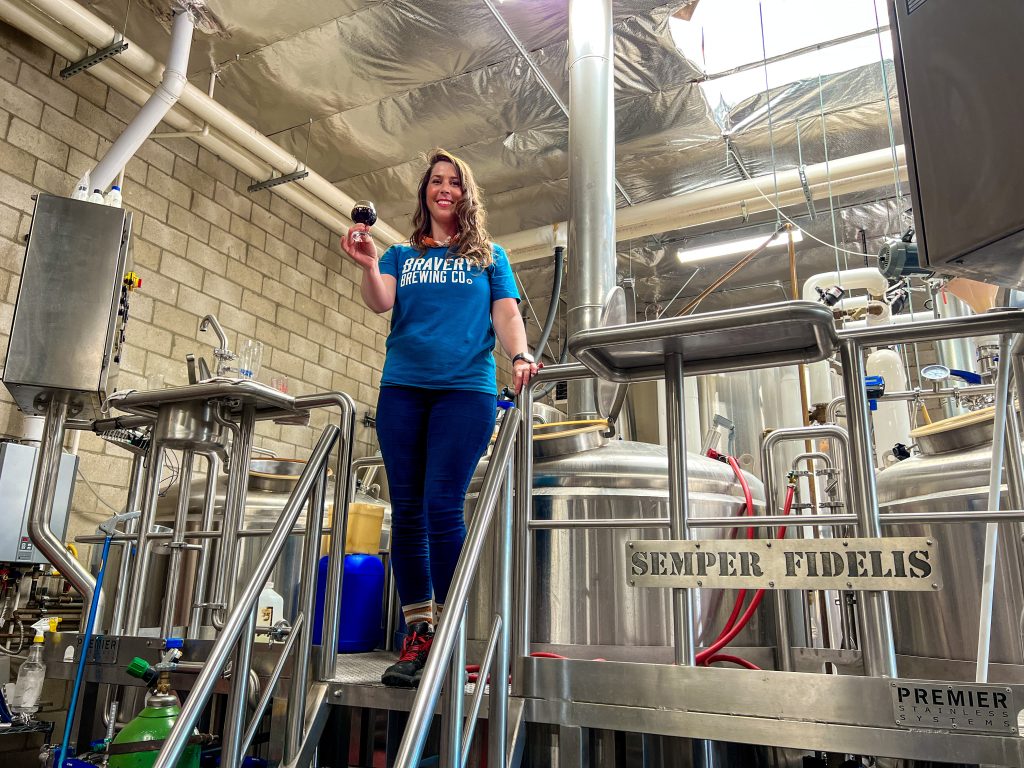
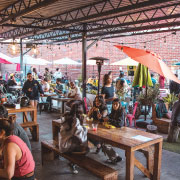
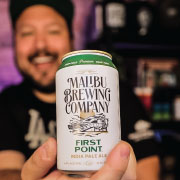

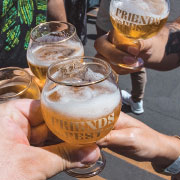
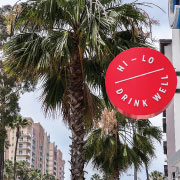
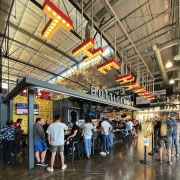
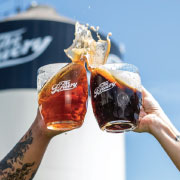
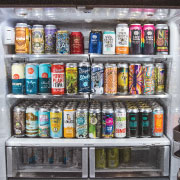
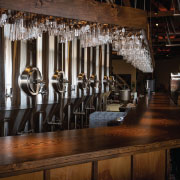
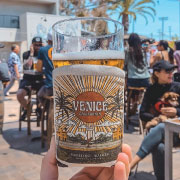
 Cambria Findley-Grubb
Cambria Findley-Grubb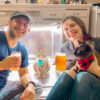 Mark Smolyar
Mark Smolyar
